Hyundai Santa Fe: Engine Control System / Engine Control Module (ECM). Repair procedures
| •
|
If you replace the PCM, you must perform oil pressure characteristics
back up & input (TCU Replacement).
(Refer to Automatic Transaxle System - "Automatic Transaxle
Control System")
|
|
| •
|
When replacing the ECM, the vehicle equipped with the immobilizer
must be performed procedure as below.
|
[In the case of installing used ECM]
| 1) |
Perform "ECM Neutral mode" procedure with diagnostic tool.
(Refer to Body Electric System - "Immobilizer System")
|
| 2) |
After finishing "ECM Neutral mode", perform "Key teaching" procedure
with diagnostic tool.
(Refer to Body Electric System - "Immobilizer System")
|
[In the case of installing new ECM]
| –
|
Perform "Key teaching" procedure with diagnostic tool.
(Refer to Body Electric System - "Immobilizer System")
|
|
| •
|
When replacing the ECM, the vehicle equipped with the smart
key system (Button start) must be performed procedure as below.
|
[In the case of installing used ECM]
| 1) |
Perform "ECM Neutral mode" procedure with diagnostic tool.
(Refer to Body Electric System - "Smart Key")
|
| 2) |
After finishing "ECM Neutral mode", insert the key (or press
the start button) and turn it to the IGN ON and OFF position.
Then the ECM learns the smart key information automatically.
|
[In the case of installing new ECM]
| –
|
Insert the key (or press the start button) and turn it to the
IGN ON and OFF position. Then the ECM learns the smart key information
automatically.
|
|
|
1. |
Turn the ignition switch OFF and disconnect the battery negative (-)
terminal.
|
|
2. |
Remove the air cleaner assembly.
(Refer to Engine Mechanical System - "Air Cleaner")
|
|
3. |
Disconnect the ECM connector (A).
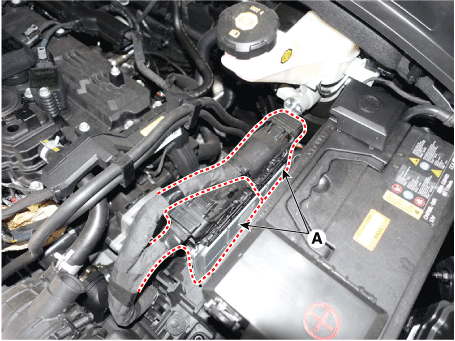
|
|
4. |
Remove the mounting bolt (A) and nuts (B), and then remove the ECM (C).
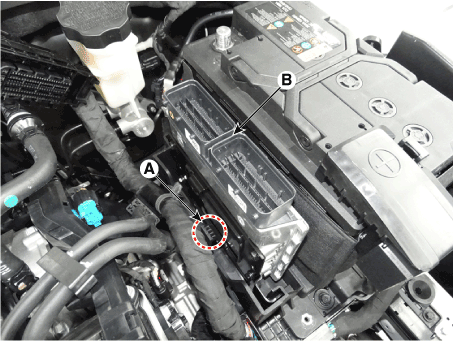
|
| •
|
When replacing the ECM, the vehicle equipped with the immobilizer
must be performed procedure as below.
|
[In the case of installing used ECM]
| 1) |
Perform "ECM Neutral mode" procedure with diagnostic tool.
(Refer to Body Electric System - "Immobilizer System")
|
| 2) |
After finishing "ECM Neutral mode", perform "Key teaching" procedure
with diagnostic tool.
(Refer to Body Electric System - "Immobilizer System")
|
[In the case of installing new ECM]
| –
|
Perform "Key teaching" procedure with diagnostic tool.
(Refer to Body Electric System - "Immobilizer System")
|
|
| •
|
When replacing the ECM, the vehicle equipped with the smart
key system (Button start) must be performed procedure as below.
|
[In the case of installing used ECM]
| 1) |
Perform "ECM Neutral mode" procedure with diagnostic tool.
(Refer to Body Electric System - "Smart Key")
|
| 2) |
After finishing "ECM Neutral mode", insert the key (or press
the start button) and turn it to the IGN ON and OFF position.
Then the ECM learns the smart key information automatically.
|
[In the case of installing new ECM]
| –
|
Insert the key (or press the start button) and turn it to the
IGN ON and OFF position. Then the ECM learns the smart key information
automatically.
|
|
|
1. |
Install in the reverse order of removal.
|
| ECM Problem Inspection Procedure |
|
1. |
TEST ECM GROUND CIRCUIT : Measure resistance between ECM and chassis
ground using the backside of ECM harness connector as ECM side check
point. If the problem is found, repair it.
|
|
2. |
TEST ECM CONNECTOR : Disconnect the ECM connector and visually check
the ground terminals on ECM side and harness side for bent pins or poor
contact pressure. If the problem is found, repair it.
|
|
3. |
If problem is not found in Step 1 and 2, the ECM could be faulty. If
so, make sure there were no DTC's before swapping the ECM with a new
one, and then check the vehicle again. If DTC's were found, examine
this first before swapping ECM.
|
|
4. |
RE-TEST THE ORIGINAL ECM : Install the original ECM (may be broken)
into a known-good vehicle and check the vehicle. If the problem occurs
again, replace the original ECM with a new one. If problem does not
occur, this is intermittent problem.
(Refer to "Intermittent Problem Inspection Procedure" in Basic Inspection
Procedure)
|
VIN Programming Procedure
VIN (Vehicle Identification Number) is a number that has the vehicle's information
(Maker, Vehicle Type, Vehicle Line/Series, Body Type, Engine Type, Transmission
Type, Model Year, Plant Location and so forth. For more information, please
refer to the group "GI" in this SERVICE MANUAL). When replacing an ECM, the
VIN must be programmed in the ECM. If there is no VIN in ECM memory, the fault
code (DTC P0630) is set.
| •
|
The programmed VIN cannot be changed. When writing the VIN,
confirm the VIN carefully
|
|
|
1. |
Turn OFF the ignition switch.
|
|
2. |
Connect the diagnostic tool to Data Link Connector (DLC).
|
|
3. |
Turn ON the ignition switch.
|
|
4. |
Select "Vehicle, Model Year, Engine, System".
|
|
5. |
Select "Vehicle S/W Management".
|
|
6. |
Select "Write VIN".
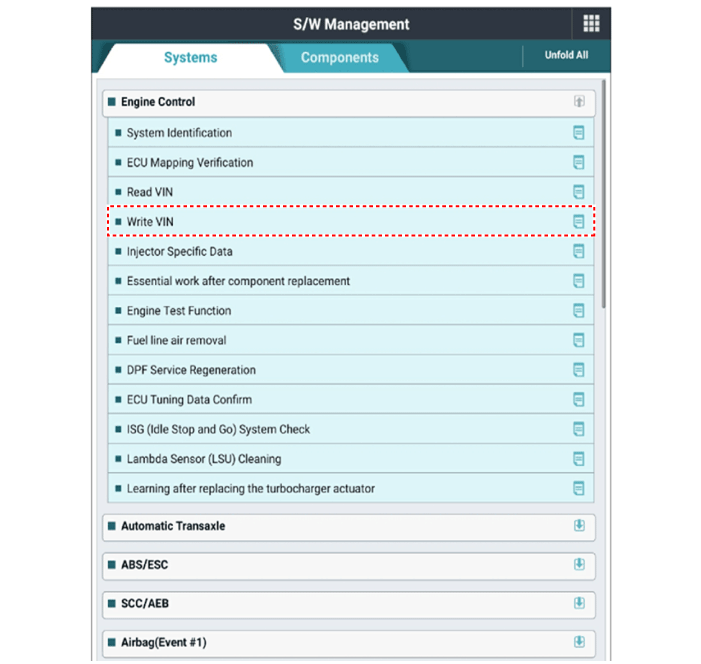
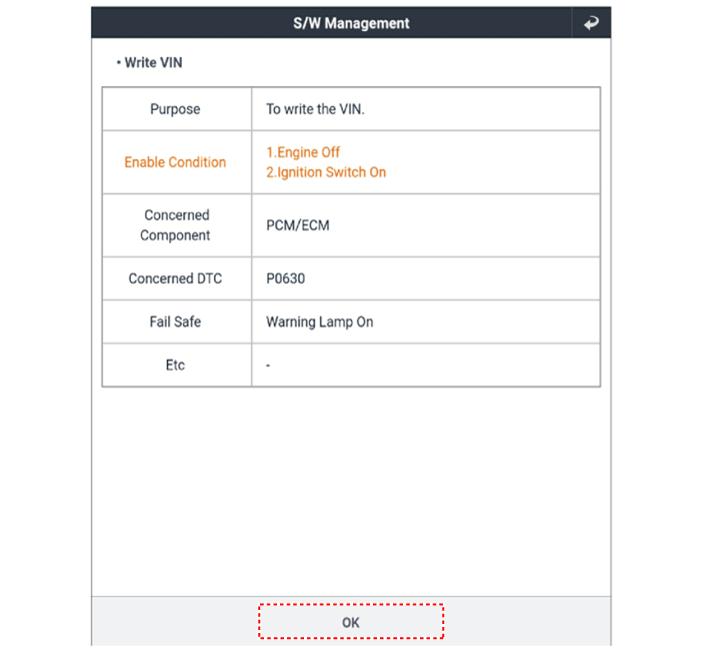
|
|
7. |
Input the VIN.
|
• |
Before inputing the VIN, confirm the VIN again because
the programmed VIN cannot be changed.
|
|
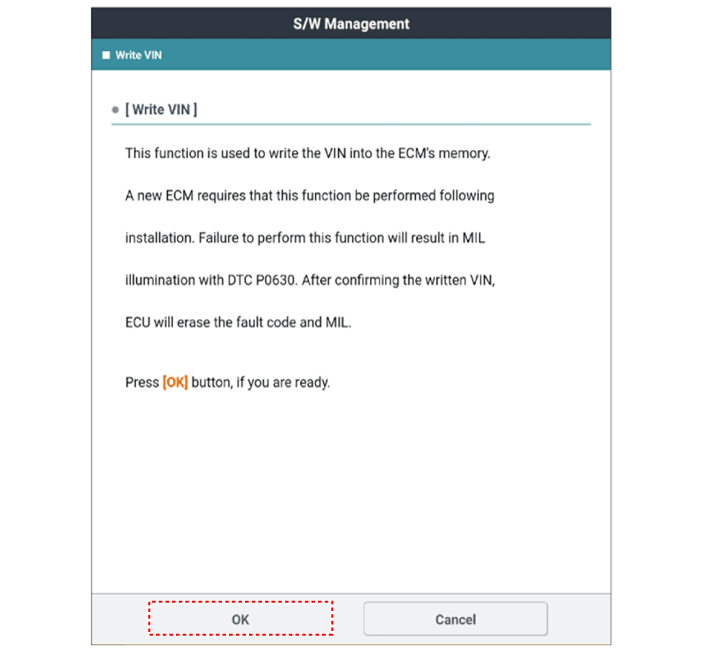
|
ECM Terminal and Input/Output
signal
ECM Terminal Function
Connector A
Pin No
Description
Connected to
1
Power ground
Chassis Ground
2
-
-
3
-
-
4
-
-
5
-
-
6
Fuel Sender Signal
Fuel Sender
7
-
-
8
-
-
9
-
-
10
-
-
11
-
-
12
-
-
13
-
-
14
-
-
15
Stop Lamp Signal
Stop Lamp
16
Brake Test Switch
Brake Switch
17
18
-
19
-
20
Output Speed (Supply)
ATM Solenoid Valve (Otput Speed)
21
Input Speed (Supply)
ATM Solenoid Valve (Input Speed)
22
-
-
23
-
-
24
-
-
25
-
-
26
-
-
27
[A/T] SOL...
Other information:
In some circumstances resetting the power liftgate operation may need to be performed.
Some instances where resetting the power liftgate may be required include:
When the 12-volt battery is recharged
When the 12-volt battery is reinstalled after removal or replacement
When the related fuse is reinstalled after removal or replacement
1...
Removal
•
Be careful not to damage the parts located under the vehicle
(floor under cover, fuel filter, fuel tank and canister) when
raising the vehicle using the lift...
Categories
Engine oil pressure warning light
.png)
This warning light illuminates:
When the engine oil pressure is low.
If the engine oil pressure is low:
1. Drive carefully to the nearest safe location and stop your vehicle.
2. Turn the engine off and check the engine oil level (For more details, refer
to “Engine Oil” section in chapter 9). If the level is low, add oil as required.
read more
 Engine Control Module (ECM). Schematic diagrams
Engine Control Module (ECM). Schematic diagrams.png)









